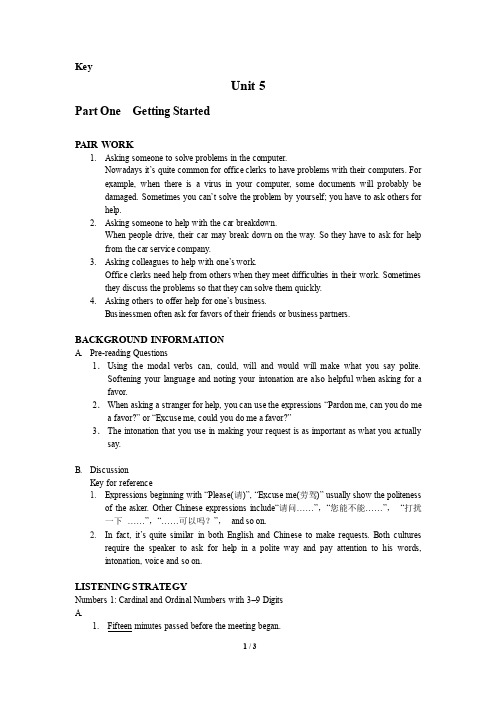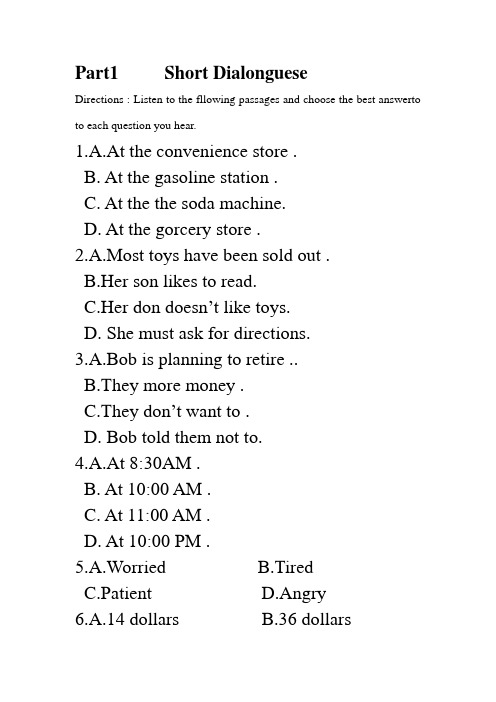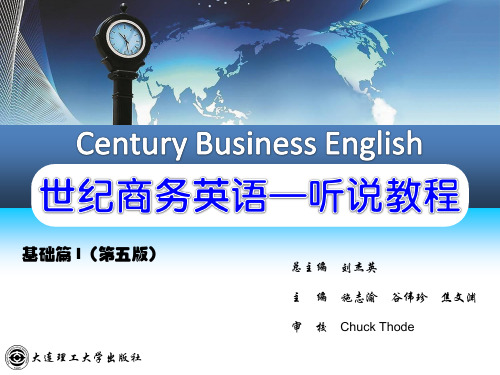商务英语听说教程
商务英语听说教程下unit1 Customer Service

*
Pre-listening Listening
Part A Part B
Further Practice Activities
*Pre-listening
good attitude after sales refund
replacement
customer service
satisfactory
I’ll see what I can do.
Refunds are allowed.
Apology
I’ m sorry, there certainly seems to be a mistake.
I’ m terribly sorry about the misunderstanding.
Please accept my apology on behalf of the hotel.
Requiring customer service
Can I get refunds?
I’d like a refund, please.
I’d be grateful if you would replace…immediately.
Providing customer service
How may I help you today?
you. Could you please tell me the reason why you want to
return it? Is there any problem with our product or service ?
C:No,no.It was just the wrong size.
8.customize (v.) 9.end user (n.) 10.scout for
商务英语视听说教程2:U7U8答案(姜荷梅第二版).doc

商务英语视听说教程2: U7U8答案(姜荷梅第二版)一、Unit 7 答案1. Listening (听力)Part A (第一部分)1.B2.A3.C4.B5.A6.C7.B8.CPart B (第二部分)9.conference room10.provide some training11.make a presentation12.improve their performance13.schedule a meeting14.make a reservation15.arrange a business trip16.book a flightPart C (第三部分)17.training program18.market research19.customer satisfaction20.business trip21.job interview22.team building23.product launch24.staff meeting2. Speaking (口语)Part A (第一部分)篇章内容:Steve: Hi Karen, have you finished the report?Karen: Yes, I have. I just need to double-check a few details.Steve: Great. If it’s ready, can you send it to me via email?Karen: Sure, I’ll send it to you right away.Steve: Thanks, Karen. I appreciate your hard work on this project.Karen: No problem, Steve. It was a team effort. We all worked together to get it done.Steve: That’s true. We make a great team.Karen: Absolutely. We have a lot of talented individuals on our team.Steve: We should celebrate our success. Let’s go out for lunch tomorrow.Karen: Sounds good. We can discuss future projects and ideas over lunch.Steve: Perfect. I’ll book a table at our favorite restaurant.Karen: Thanks, Steve. Looking forward to it.Steve: Me too. See you tomorrow.Karen: See you then.Part B (第二部分)题目:Discussing Upcoming Business Trips篇章内容:Mike: Hi Lisa, I heard you will be going on a business trip soon. Where will you be going?Lisa: Yes, I will be traveling to Tokyo next week.Mike: That sounds exciting. What is the purpose of your trip?Lisa: I’ll be attending a conference and meeting with our Japanese business partners.Mike: Have you made all the necessary arrangements?Lisa: Yes, I have booked my flight and hotel. I also prepared a detailed itinerary.Mike: That’s great. Is there anything I can help you with?Lisa: Actually, I have never been to Tokyo before. Do you have any recommendations for sightseeing or restaurants?Mike: Sure, I can give you some suggestions. I’ll send you an email with all the information.Lisa: Thank you, Mike. I really appreciate your help.Mike: No problem, Lisa. I hope you have a successful trip.Part C (第三部分)题目:Discussing Performance Evaluation Results篇章内容:Kate: Hi Mark, have you received your performance evaluation results?Mark: Yes, I received them this morning. How about you?Kate: I got m ine too. Let’s discuss our results and see how we can improve.Mark: Sure, let’s go through the feedback we received.Kate: Overall, my evaluation was positive. However, there are a few areas for improvement.Mark: Same here. I need to work on my time management and communication skills.Kate: It’s good that we are aware of our weaknesses. We can create a plan to address them.Mark: Definitely. We can also seek guidance from our supervisor if needed.Kate: That’s a good idea. Let’s schedule a meeting wi th him to discuss our performance goals.Mark: Great. I’ll send an email to arrange the meeting.Kate: Thank you, Mark. I’m confident we can grow and excel in our roles.二、Unit 8 答案1. Listening (听力)Part A (第一部分)1.B2.A3.C4.C5.B6.A7.B8.CPart B (第二部分)9.product promotion10.market segmentation11.advertising campaign12.customer loyalty13.brand image14.target audience15.sales strategypetitive advantagePart C (第三部分)17.market research18.product launch19.advertising budget20.sales forecast21.marketing strategy22.customer feedback23.brand awareness24.online advertising2. Speaking (口语)Part A (第一部分)篇章内容:John: Hi Lisa, have you heard about the new advertising campaign?Lisa: Yes, I have. It’s a great initiative to promote our new products.John: Definitely. The ads are catchy and the message is clear.Lisa: I agree. It will definitely grab the attention of our target audience.John: We should also leverage social media to reach a wider audience.Lisa: That’s a good idea. We can create engaging content and run targeted ads.John: We should also monitor customer feedback and respond quickly.Lisa: Absolutely. Customer satisfaction is key to building brand loyalty.John: I’m confident that this campaign will boost our sales and brand image.Lisa: Me too. Let’s work together to ensure its succe ss.John: Sounds like a plan. Let’s schedule a meeting to discuss the details.Lisa: Perfect. I’ll check our calendars and send an invitation.Part B (第二部分)题目:Discussing New Product Launch篇章内容:Emily: Hi Mike, have you heard about the new product launch?Mike: Yes, I have. The new product looks promising.Emily: Indeed. We need to create an effective marketing strategy to introduce it to the market.Mike: Agreed. We should conduct market research to identify our target audience.Emily: We also need to establish a budget for advertising and promotional activities.Mike: That’s right. We should allocate resources wisely to maximize the impact.Emily: We can leverage digital marketing channels to reach a wider audience.Mike: Absolutely. Social media and online advertising are essential in today’s digital age.Emily: We should also plan a product launch event to generate buzz and media coverage.Mike: I’ll start working on the marketing plan and get back to you with the details.Emily: Great, I’m looking forward to it. Let’s make this launch a big success.Part C (第三部分)题目:Discussing Sales Strategy篇章内容:Tom: Hi Sarah, let’s discuss our sales strategy for the upcoming quarter.Sarah: Sure, Tom. We need to set realistic sales targets to drive performance.Tom: I agree. We should also analyze market trends and adjust our strategy accordingly.Sarah: We need to identify our competitive advantage and highlight it in our sales pitch.Tom: Absolutely. Differentiating ourselves from competitors will give us an edge.Sarah: We should also focus on building long-term customer relationships to enhance customer loyalty.Tom: That’s a good point. Happy customers will recommend our products to others.Sarah: We should also train our sales team to effectively communicate the value of our products.Tom: I’ll schedule a training session to ensure our team is equipped with the necessary skills.Sarah: Thank you, Tom. Together, we can achieve our sales goals and exceed expectations.三、总结本文档为《商务英语视听说教程2: U7U8答案(姜荷梅第二版)》的答案文档,包含了Unit 7和Unit 8的听力和口语部分的答案。
Key_U5_01 Getting Started商务英语视听说教程1

KeyUnit 5Part One Getting StartedPAIR WORK1.Asking someone to solve problems in the computer.Nowadays it’s quite common for office clerks to have problems with their computers. For example, when there is a virus in your computer, some documents will probably be damaged. Sometimes you can’t solve the problem by yourself; you have to ask others for help.2.Asking someone to help with the car breakdown.When people drive, their car may break down on the way. So they have to ask for help from the car service company.3.Asking colleagues to help with one’s work.Office clerks need help from others when they meet difficulties in their work. Sometimes they discuss the problems so that they can solve them quickly.4.Asking others to offer help for one’s business.Businessmen often ask for favors of their friends or business partners.BACKGROUND INFORMATIONA.Pre-reading Questions1.Using the modal verbs can, could, will and would will make what you say polite.Softening your language and noting your intonation are also helpful when asking for a favor.2.When asking a stranger for help, you can use the expressions “Pardon me, can you do mea favor?” or “Excuse me, could you do me a favor?”3.The intonation that you use in making your request is as important as what you actually say.B.DiscussionKey for reference1.Expressions beginning with “Please(请)”, “Excuse me(劳驾)” usually show the politenessof the asker. Other Chinese expressions include“请问……”,“您能不能……”,“打扰一下……”,“……可以吗?”,and so on.2.In fact, it’s quite similar in both English and Chinese to make requests. Both culturesrequire the speaker to ask for help in a polite way and pay attention to his words, intonation, voice and so on.LISTENING STRATEGYNumbers 1: Cardinal and Ordinal Numbers with 3–9 DigitsA.1.Fifteen minutes passed before the meeting began.2.He was born in 1990.3.Great changes took place in the 1980’s in China.4.The flight is due to arrive at 7:30 p.m.5.This group is made up of 32 girls and 17 boys.6.It is reported that hourly servants will be paid 50 yuan per hour during the SpringFestival holidays.7.Mr. Green lives at 516, 5th Street.8.I spent 2,314 yuan on my mobile phone.9.Sixty people were invited to attend the party, but only half of them showed up.10.Students are required to read the passage at the rate of 130 words per minute.B.1.Only one-fifth of the students in this class are boys.2.She got the second in the race.3.Judy and Billy’s wedding will be held on June the 6th.4.October the 1st is our National Day.5.The 29th Olympic Games were held in Beijing in 2008.6.The British drama The King’s Speech won the Oscar for the Best Picture at the 83rdAcademy A wards ceremony.7.The old couple will celebrate their 50th anniversary next Saturday.8.This is the fourth time for him to see the film.9.Two-thirds of the earth is covered with water.10.A strong earthquake hit Sichuan Province on May the 12th 2008.C.1.515= five hundred and fifteen2.890= eight hundred and ninety3.2,010= two thousand and ten4.6,344= six thousand, three hundred and forty-four5.13,897= thirteen thousand, eight hundred and ninety-seven6.712,765= seven hundred and twelve thousand, seven hundred and sixty-five7.3,055,102= three million, fifty-five thousand, one hundred and two8.47,503,911= forty-seven million, five hundred and three thousand, nine hundred andeleven9.680,432,705= six hundred and eighty million, four hundred and thirty-two thousand,seven hundred and five10.108,478,208= one hundred and eight million, four hundred and seventy-eight thousand,two hundred and eightD.The number of people over age 60 is expected to increase two times during the next 50 years. A new United Nations population study says the percentage of old people in the world is rising quickly. Today, one of every ten people is over age 60. By the middle of the next century, one in five people in the world will be 60 years old or older. That will be almost twobillion people. This means there will be more old people in the world than children. Experts say many developing countries do not have the social services to help the increasing number of old people. The current life expectancy is 66 years. The oldest of the old people are also living longer. Twelve percent of old people are 80 years old and older. The world’s population is getting older because death rates and birth rates have decreased. The reduction in these rates has been a great success. The UN study also found that women still live longer than men. For every 100 women in the world aged 60 or over, there are only 81 men.。
世纪商务英语听说教程三

Part1 Short DialongueseDirections : Listen to the fllowing passages and choose the best answerto to each question you hear.1.A.At the convenience store .B. At the gasoline station .C. At the the soda machine.D. At the gorcery store .2.A.Most toys have been sold out .B.Her son likes to read.C.Her don doesn’t like toys.D. She must ask for directions.3.A.Bob is planning to retire ..B.They more money .C.They don’t want to .D. Bob told them not to.4.A.At 8:30AM .B. At 10:00 AM .C. At 11:00 AM .D. At 10:00 PM .5.A.Worried B.TiredC.PatientD.Angry6.A.14 dollars B.36 dollarsC.50 dollarsD.64 dollars7.A.Swim in the pool .B.Take a sightseeing tour .C.Eat in her room .D.Call the restaurant .8.A.Make sure it is raining .B.Check the forecast .C.Take an umbrella .D.Call later today .9.A.Jan B.Mr.JonesC.Mr.SandersD.Mr.Sanders’ secretary10.A.Six months B.Nine monthsC.From August to OctoberD.Three months Part 2Conversations 1Conversations 1Task 1Directions:Listen to the first conversation once and choose the best answer to complete each of the following statements .1.The goods are .A.color TV sets, 30 inches .B. color TV sets,32 inches .C. color TV sets,23 inches .D. color TV sets,20 inches .2.The unit price is .$300 per set CIF San FranciscoB. US$300 per set CIF SantiagoC. US$200 per set CIF San FranciscoD. US$200 per set CIF Santiago3.The shipment is to be made in 3 equal monthly installments of each month form Feb . 2007 . A.40,000 sets B.30,000 setsC.20,000 setsD.10,000 sets4.The outer packing is to be strengthened by .A.jute ropeB.nylon strapsC.sisal ropeD.plastic steaps5.The insurance cover .A.AR and T.P.N.DB.All Risks and WPAC. AR and FPAD. All Risks and F.W.R.D Task 2Directions: Listen to the first conversation again and fill in the contract .Sales ContractCommodity:Color TVQuantity: (1).Total price : (2) US$Payment : L/C payable against presentation of (3) . Packing:Each TV set is to be wrapped in a (4) .fixed with plastic padding and put in a carton .Insurance: To be effected with PICC for (5) . against All Risks and T.P.N.D.Conversations 2Directions:You will hear an interview between a journalist and a top businessman Paul Smith .The journalist is going to write an article called “A day in the life of Paul Smith’.Look at the different activities in the table below .As you listen ,note the sequence of events in Paul Smith’s typicalday. Some of them have been done for you .Events SequenceVisit the plant ( )Run through the agenda for the day ( )Have breakfast ( ) Meetings with Finance and Sales Directors ( ) Read a book ( )Get up ( 1 ) Dinner engagement ( ) Go for a jog ( ) Lunch in the canteen ( ) Read the newspapers ( ) Finish work ( ) Go to sleep ( )。
01 Getting Started商务英语视听说教程1

Introductions and Greetings
In social situations, a man is traditionally introduced to a woman (notice that the woman’s name is mentioned first); a younger person to an older person; a less important person to a more important person. However, in the business world the order is based on a person’s rank (等级) or position in a company rather than on age or gender (性别). A lower-ranking person is introduced to a higher-ranking person. That is, you say the name of the higher-ranking person first. But there is an exception to this rule: the highest-ranking person in a company does not out-rank (地位高于) a client (客户). In this case, the client’s name should be mentioned first. (e.g., Mr. Green, this is Ms. Smith, our Chief Financial Officer [财务主管]. Ms. Smith, this is Mr. Green, our client
商务英语听说教程上 Unit 5Business Meeting

Task 2 Role-play Make a role-play in groups of four with the help of the following situation.
Company X is going to have a meeting. The chairman will preside the meeting. Speaker A says that the new products has made a great success and suggests an increase in the production. Speaker B asks the chairman if it would be possible for the company to have a farewell party for the Senior Accountant who has been with the company since its formation 30 years ago and now is due to retire and if the chairman could make a speech at the dinner. Speaker C reports the progress in the company’s moving to a new building.
spare copies of the agenda on the table. Alisa: I see. I’ve already done that. David: What about the projector ? Alisa: There was something wrong with the screen but it has been repaired. David: Well done, I have come to tell you that you have to take the minutes during the meeting. Alisa: Should I write down all words that everyone says? David: No. it is unnecessary and difficult to write down all words, you just make a note of the topic which are discussed and the results of the discussion . Alisa: That’s OK. David: So everything is clear. I hope our organization of the meeting will be successful. Alisa: So do I.
世纪商务英语听说教程基础篇1-Unit-3PPT课件

听力原文
1. The number of the passengers on the plane was .
A. over 228
B. 228
C. less than 228
2. The Air France plane crashed into .
A. the Pacific Ocean
spot step skin play climb globe through spread splendid squad helped sobbed
-
sport stir skate plant class glide throw sprinkle spleen squeeze
7
Training Focus
10. They were longing to see the (night, light) when trapped underground.
-
4
Training Focus
Section A
Task Two
Listen to the following sentences and choose the correct words you hear from the choices.
基础篇 I(第五版)
大连理工大学出版社
总主编 刘杰英 主 编 施志渝 谷伟珍 焦文渊 审 校 Chuck Thode
Unit 3 Sorry to Hear That.
Learning Objectives
1. To be able to distinguish between similar consonants 2. To get familiar with consonant clusters 3. To be able to grasp sympathy and consolation expressions 4. To be able to express your sympathy and consolation
商务英语听说教程下unit9Disputes and Claim共16页文档

Part A - Task 2 Conversation
1.Listen to the conversation once and answer the following question.
The buyer requests an indemnity from the seller because of
Part B - Task 1 Vocabulary Building
Match the English word or phrase with its Chinese translation.
Part B - Task 2 Conversation
1.Listen to the conversation once and answer the following questions. Why does the buyer file a claim against the seller?
transit. ( F) The seller has not discovered the exact causes of the damage. ( T) The goods were sold on CIF Boston basis. (F)The tin cans were broken through careless handling while be - Task 2 Conversation
Settling a claim We are not liable for the damage. It is a case of force majeure which is beyond our control. It is clearly a case for which the underwriters should take responsibilities. The claim should be referred to the ship owner. We are sorry we can’t entertain your claim. We regret our inability to accommodate your claim. According to the contract, a minor discrepancy in colors is permissible. After making a thorough investigation, we have decided to accept your claim. We will compensate for your loss if we were responsible for it. We hope this unfortunate incident will not affect the relationship between us. The claim is not well supported by facts. The claim is unfounded. We can assure you that such a thing will not happen again in future deliveries. I’m afraid we can’t accept your return because the guarantee has expired.
